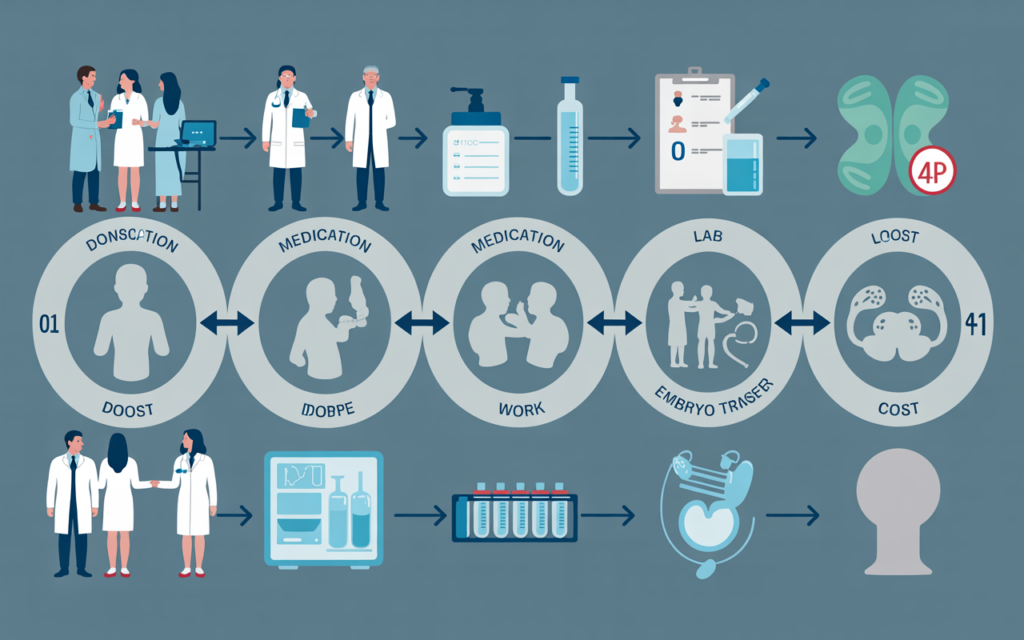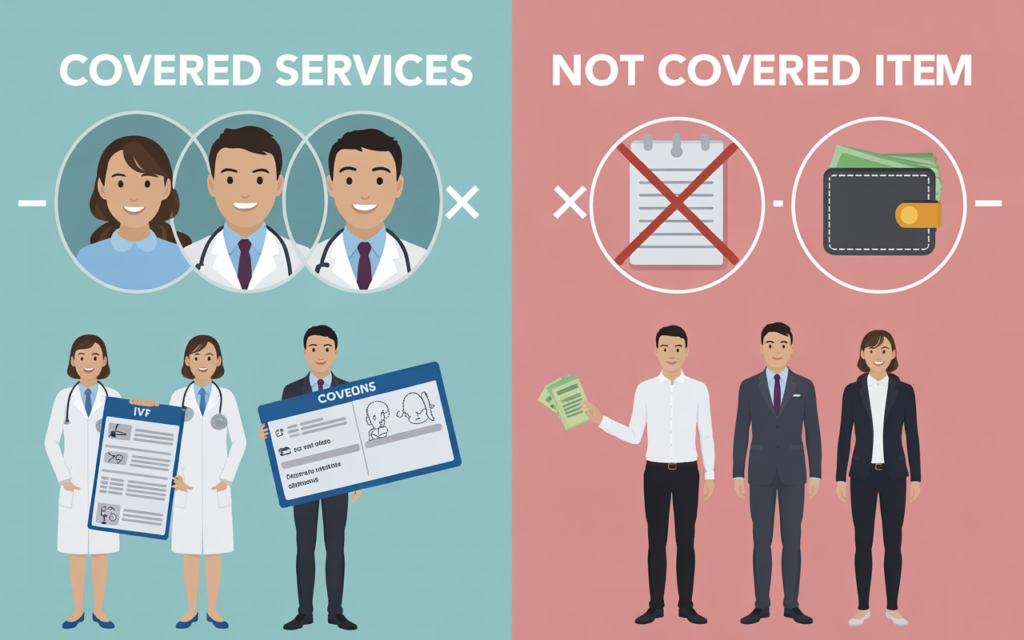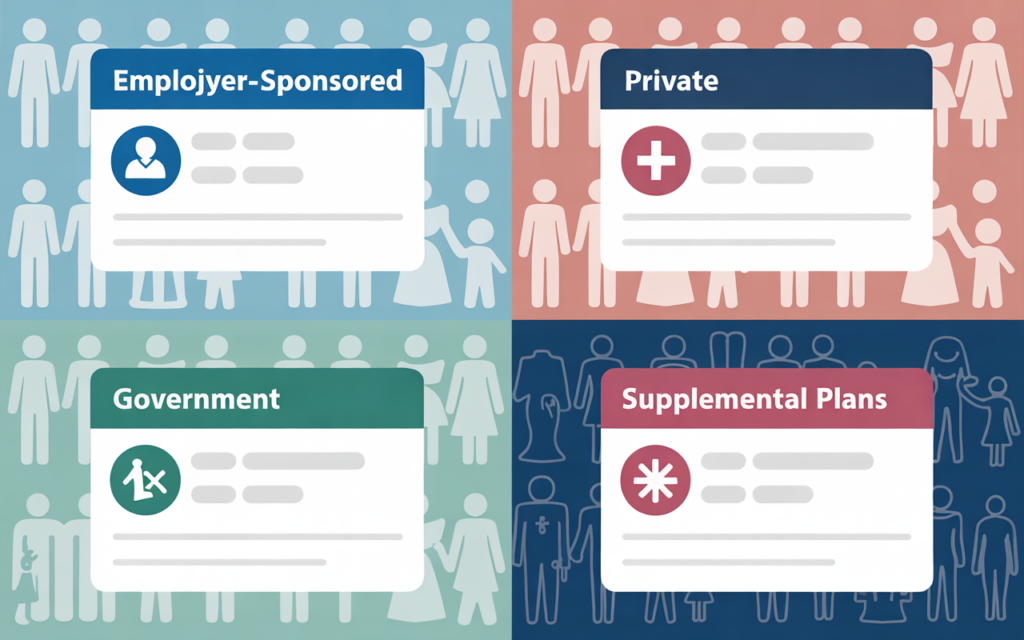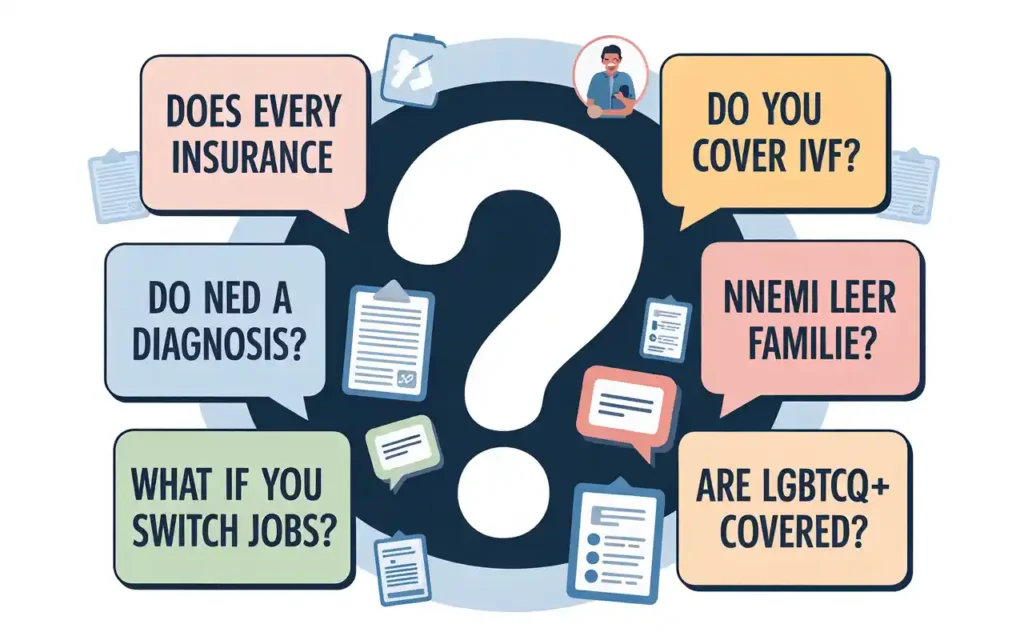For millions worldwide, in vitro fertilization (IVF) represents hope—a pathway to parenthood often after years of disappointment, heartbreak, and failed attempts. Yet with IVF cycles routinely costing between $10,000 and $30,000, the question of what health insurance covers IVF is no less than fundamental.
Insurance coverage—or a lack thereof—means the difference between pursuing IVF or postponing, even abandoning, parenthood ambitions. Medical advancements have turbocharged IVF success rates and options, but insurance policies haven’t kept up, remaining inconsistent, confusing, and often inadequate.
In today’s world, the path to parenthood often isn’t as simple as trying and conceiving naturally. For millions of individuals and couples around the globe, building a family involves navigating infertility and turning to advanced reproductive technologies like in vitro fertilization (IVF) for help. While IVF offers new hope and life-changing outcomes, the process is undeniably expensive and emotionally demanding. This is where health insurance can—and should—play a vital role. But here’s the catch: what health insurance covers IVF is not uniform. It can vary dramatically by country, state, insurance provider, employer, and even your specific medical diagnosis.
Many people end up asking the same difficult questions: “Is IVF covered under my insurance?”, “How many cycles will be paid for?”, “Is medication also covered, or just the procedures?” The answers to these questions are rarely straightforward. In fact, some insurance plans may offer generous fertility benefits that cover multiple IVF cycles, medication, and even genetic testing—while others may not cover anything beyond the initial fertility assessment.
For couples or individuals in countries like Nigeria, where fertility treatment is primarily out-of-pocket, the financial burden can be a major barrier. In contrast, some European countries subsidize IVF through public programs, but access is often limited by strict eligibility criteria, age limits, or relationship status. This inconsistency leads to confusion, frustration, and sadly, delays in receiving care—especially at a time when emotions, finances, and timelines are already fragile.
There’s no sugar-coating the reality: without health insurance coverage, IVF is a luxury that many simply cannot afford. It isn’t rare for individuals to take out loans, deplete their savings, or resort to crowdfunding just to pursue a single IVF cycle. What should be a hopeful new chapter can instead become a source of deep anxiety and stress.

That’s why understanding what health insurance covers IVF has never been more important. Whether you’re planning ahead, actively undergoing treatment, or simply exploring your options after a fertility diagnosis, knowing what your health plan includes (and excludes) is essential. And if IVF isn’t covered at all? Don’t worry—this guide will also walk you through alternative paths and practical strategies to make informed, proactive decisions.
In this in-depth guide, we’ll demystify what IVF is, how much it typically costs, how insurance policies approach fertility care, and what steps you can take to fight for better access. You’ll also find real-world examples, questions to ask your insurer, and tips to get the most out of your health plan—no matter where you live.
Because building a family should never be determined by fine print—and everyone deserves a chance at creating the future they dream of.
Would you like me to continue expanding another section, or format this as a newsletter or blog post introduction?
Why Coverage Matters More Than Ever
Financial barriers and unpredictable out-of-pocket costs are the biggest obstacles couples face in the IVF process. Many undergo multiple rounds before conceiving—compounding expenses. Medications, genetic testing, donor services, embryo freezing, and eventual transfer each add distinct costs.
Example: In Nigeria, most health insurers categorize IVF as elective or experimental, rarely offering financial support. Meanwhile, in the United States, coverage often depends on your employment benefits, state of residence, and your insurer’s fertility policy.
Deep Dive: The IVF Process and True Costs

Understanding the IVF timeline and its components is key to evaluating your insurance options.
The IVF Cycle: Step-by-Step
- Initial Fertility Assessments: Includes blood tests, ultrasound scans, semen analysis, and hormonal profiling.
- Ovarian Stimulation: Hormone injections for 8–14 days, monitored closely with regular scans and tests to track follicle development.
- Egg Retrieval: Outpatient procedure under sedation. Eggs are harvested using ultrasound guidance.
- Sperm Collection and Preparation: Typically involves collecting a sperm sample or surgical sperm retrieval in more complex cases.
- Fertilization and Embryo Culture: Eggs are fertilized with sperm in the lab and monitored for development over 3–5 days.
- Embryo Transfer: Healthy embryos are transferred into the uterus.
- Luteal Support & Confirmation: Hormonal medications support the uterine lining, followed by pregnancy tests and early scans.
IVF Cost Breakdown
- Initial Consultations and Diagnostic Tests: $2,000–$5,000
- Medications: $3,000–$8,000 per cycle
- Egg Retrieval and Fertilization Process: $6,000–$15,000
- Embryo Transfer: $3,000–$5,000
- Embryo Cryopreservation (Freezing): $1,000–$2,000/year
- Add-ons (PGT, ICSI, donor sperm/egg): $2,000–$10,000+
Costs can escalate depending on location, clinic reputation, medical complexity, and the number of required cycles.
The Global Landscape: Health Insurance and IVF Coverage
The extent to which insurance covers IVF varies widely by region, especially between the U.S., UK, Nigeria, and other countries.
IVF Coverage in the United States
Some U.S. states like Massachusetts, Connecticut, and Illinois mandate limited infertility benefits, including IVF. However, this often applies only to fully-insured large group plans. Self-insured plans and others may not follow state mandates.
Large corporations increasingly offer comprehensive fertility coverage, particularly in the tech, finance, and healthcare industries.
IVF Coverage in Nigeria and Sub-Saharan Africa
Most insurers view IVF as an elective procedure, offering minimal or no coverage. Some private hospitals and clinics offer bundled packages or financing options for patients to manage costs.
IVF Coverage in the UK and Europe
In the UK, the NHS covers up to three IVF cycles for eligible couples, but criteria—such as age, BMI, prior children, and time trying—vary by local NHS trust. In countries like Israel and France, IVF is heavily subsidized under public healthcare.
IVF in Asia, Australia, and the Middle East
Australia offers partial rebates under its Medicare program, but out-of-pocket costs still apply. IVF treatment in the Middle East and many Asian countries is often available only to those who can pay privately, although some states offer limited subsidies.
Factors That Influence What Health Insurance Covers IVF

Your access to fertility treatments through insurance depends on several factors.
- Legal Mandates: Some countries or states require fertility benefits as part of health coverage.
- Policy Type: Public, private, group/employer-sponsored, or supplemental plans offer varied fertility benefits.
- Infertility Diagnosis: Most insurers only cover IVF if labeled “medically necessary” via formal diagnosis (e.g., blocked fallopian tubes, male factor infertility).
- Patient Demographics: Age, marital status, and sexual orientation are sometimes used to determine eligibility.
- Treatment History: Many policies require that less invasive treatments (like IUI or ovulation induction) be tried first.
Types of Health Insurance Plans and IVF Coverage

Employer-Sponsored Insurance Plans
Employers that offer fertility coverage often do so through premium policies or via third-party fertility benefit networks like Carrot Fertility or Progyny.
These plans may cover:
- Several IVF cycles per lifetime
- Fertility medications
- Donor services and cryopreservation
- LGBTQ+ and single-parent access
Private and Individual Health Insurance
Privately purchased plans often offer minimal coverage:
- Diagnostics may be covered
- IVF procedures usually excluded
- Fertility riders sometimes available for an additional premium
Government and Public Sector Coverage
Countries with public healthcare, such as the UK or Canada, may cover infertility services through national providers, but subject to eligibility. Coverage in many developing countries is limited or absent.
Supplemental Fertility Coverage
Specialized fertility benefits can be purchased to cover what traditional insurance excludes. These include maternity packages with ART coverage, IVF-specific insurance, or employer-sponsored add-ons.
Inclusions, Exclusions, and Coverage Limits
Commonly Included Under IVF Plans
- Initial diagnostics and fertility assessments
- Hormonal stimulation and monitoring
- Egg retrieval and laboratory fertilization
- Embryo transfer
- Some plans include embryo freezing and early pregnancy tests
Frequently Excluded Services
- Elective egg or sperm freezing
- Surrogacy-related costs
- Donor egg or sperm (in some cases)
- Pre-implantation genetic testing (PGT-A/PGT-M)
- Alternative or holistic therapies (e.g., acupuncture)
Common Insurance Coverage Limits
- Cycle Limits: e.g. 2–3 IVF cycles per lifetime
- Age Limits: IVF may not be covered above a certain age (often 42)
- Dollar Caps: Lifetime benefits limited to $10,000–$50,000
- Clinic Restrictions: Must use network-approved fertility centers
Medication Coverage for IVF
IVF medications can cost more than the actual procedures. The extent of coverage varies significantly.
Check your plan for:
- Formulary Listings: Only generic medications may be covered
- Pharmacy Limitations: Some require you to use a specific specialty pharmacy
- Pre-authorization Requirements: Documentation from your fertility specialist
- Separate Medication Deductibles: Distinct from your overall out-of-pocket maximum
Important drugs include:
- FSH and LH stimulants
- Egg maturation triggers like hCG
- Progesterone supplementation products
How to Verify If Your Health Insurance Covers IVF

Step-by-Step Guide
- Review Your Policy: Obtain your Summary of Benefits and Certificates of Coverage from your HR department or insurer’s portal.
- Call Your Insurer: Ask specific questions about fertility and IVF.
- Confirm Terminology: Look for key phrases like “ART,” “infertility services,” and “reproductive procedures.”
- Get Pre-authorization: Most insurers require this before procedures begin.
- Keep All Communication in Writing: Email confirmations save you from future billing disputes.
Questions to Ask Your Insurance Provider
- Is IVF covered, and under what conditions?
- Are medications included? If so, are there caps?
- How many cycles are covered per lifetime or per year?
- What is the copay or percentage I’m responsible for?
- Is embryo freezing/storage covered?
Real-World Case Studies
Case 1: IVF Through a U.S. Tech Company
A U.S.-based engineer uses employer-provided coverage for three IVF cycles, complete with medication, embryo freezing, and PGT-M testing.
Case 2: IVF via Private Insurance in Lagos
A Nigerian couple using standard health insurance finds they only qualify for infertility diagnostics. They explore clinic payment plans and fertility grants.
Case 3: UK Couple Using NHS and Private Coverage
They qualify for one NHS-funded IVF cycle. After a failed attempt, they use a private fertility insurance rider to fund two additional cycles.
Common Synonyms for IVF Insurance Coverage
Understanding different terms helps in research and insurer discussions. Watch out for:
- Fertility benefits
- Infertility treatment coverage
- ART insurance (Assisted Reproductive Technology)
- Reproductive health services
- Family-building insurance plans
Maximizing Your Health Insurance Coverage for IVF

- Leverage Employer Benefits: Discuss options with HR. Consider open enrollment season for plan upgrades.
- Consider Fertility Add-Ons or Riders: These can dramatically increase what’s covered.
- Use FSAs or HSAs: Tax-advantaged accounts help offset out-of-pocket IVF costs.
- Apply for IVF Grants: Many nonprofits offer partial or full IVF funding.
- Explore Medical Tourism: Fertility treatments in India, South Africa, or Greece are often significantly cheaper with excellent care.
Frequently Asked Questions

Does every insurance plan cover IVF?
No. It varies by region, provider, and plan type. Always request specific plan details.
Can I get coverage without an infertility diagnosis?
Usually not. Most insurers require documented medical infertility for IVF coverage.
What if I change jobs mid-treatment?
Be mindful of waiting periods and coverage gaps. Speak to both insurers and your clinic in advance.
Do LGBTQ+ or single parents face restrictions?
Some insurers offer parity, while others restrict coverage to heterosexual couples. Review your plan’s language closely.
conclusion
Navigating the world of what health insurance covers IVF can feel overwhelming. From treatments and medications to multiple cycles, managing fertility journeys without clear guidance or financial help is stressful. However, with diligent research, informed conversations, and the right planning, IVF can be more accessible than you imagined—no matter where you live or how you plan to build your family. Whether you’re based in Lagos, London, or Los Angeles, the steps are the same: Check your insurance documents carefully, talk with experts, and explore all your options. Advocating for yourself today can bring your future family one step closer tomorrow.